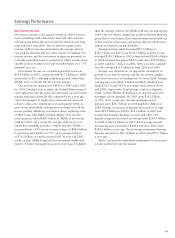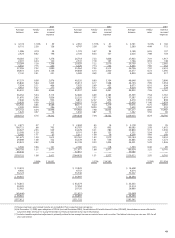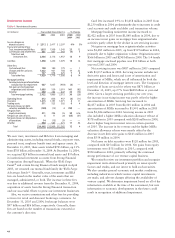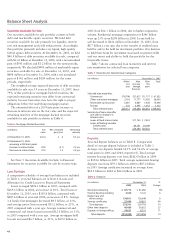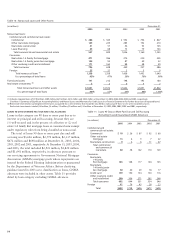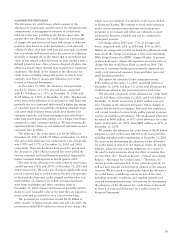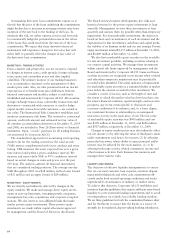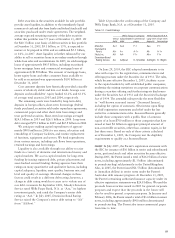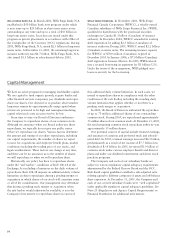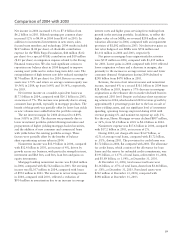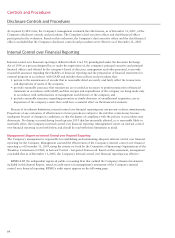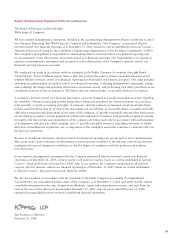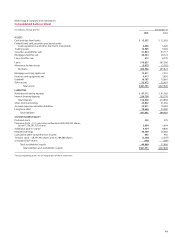Wells Fargo 2005 Annual Report Download - page 53
Download and view the complete annual report
Please find page 53 of the 2005 Wells Fargo annual report below. You can navigate through the pages in the report by either clicking on the pages listed below, or by using the keyword search tool below to find specific information within the annual report.
51
ALLOWANCE FOR CREDIT LOSSES
The allowance for credit losses, which consists of the
allowance for loan losses and the reserve for unfunded credit
commitments, is management’s estimate of credit losses
inherent in the loan portfolio at the balance sheet date. We
assume that our allowance for credit losses as a percentage
of charge-offs and nonaccrual loans will change at different
points in time based on credit performance, loan mix and
collateral values. Any loan with past due principal or interest
that is not both well-secured and in the process of collection
generally is charged off (to the extent that it exceeds the fair
value of any related collateral) based on loan category after a
defined period of time. Also, a loan is charged off when clas-
sified as a loss by either internal loan examiners or regulatory
examiners. The detail of the changes in the allowance for
credit losses, including charge-offs and recoveries by loan
category, is in Note 6 (Loans and Allowance for Credit
Losses) to Financial Statements.
At December 31, 2005, the allowance for loan losses
was $3.87 billion, or 1.25% of total loans, compared
with $3.76 billion, or 1.31%, at December 31, 2004, and
$3.89 billion, or 1.54%, at December 31, 2003. The decrease
in the ratio of the allowance for loan losses to total loans was
primarily due to a continued shift toward a higher percentage
of consumer loans in our portfolio, including consumer loans
and some small business loans, which have shorter loss
emergence periods, and home mortgage loans, which have
inherently lower losses that emerge over a longer time frame
compared to other consumer products. We have historically
experienced lower losses on our residential real estate secured
consumer loan portfolio.
The allowance for credit losses was $4.06 billion at
December 31, 2005, and $3.95 billion at December 31, 2004.
The ratio of the allowance for credit losses to net charge-offs
was 178% and 237% at December 31, 2005 and 2004,
respectively. This ratio fluctuates from period to period and
the decrease in 2005 reflects increased loss rates within the
various consumer and small business portfolios impacted by
higher consumer bankruptcies in fourth quarter 2005.
The ratio of the allowance for credit losses to total nonac-
crual loans was 303% and 291% at December 31, 2005 and
2004, respectively. This ratio may fluctuate significantly from
period to period due to such factors as the mix of loan types
in the portfolio, borrower credit strength and the value and
marketability of collateral. Over half of nonaccrual loans
were home mortgages and other consumer loans at
December 31, 2005. Nonaccrual loans are generally written
down to a net realizable value at the time they are placed on
nonaccrual and accounted for on a cost recovery basis.
The provision for credit losses totaled $2.38 billion in
2005, and $1.72 billion in both 2004 and 2003. In 2005, the
provision included $100 million in excess of net charge-offs,
which was our estimate of probable credit losses related
to Hurricane Katrina. We continue to work with customers
under various payment moratoriums and forbearance
programs to re-evaluate and refine our estimates as more
information becomes available and can be confirmed in
subsequent quarters.
Net charge-offs in 2005 were .77% of average total
loans, compared with .62% in 2004 and .81% in 2003.
Higher net charge-offs in 2005 included the additional credit
losses from the change in bankruptcy laws and conforming
Wells Fargo Financial to FFIEC charge-off rules. A portion
of these bankruptcy charge-offs represent an acceleration of
charge-offs that would have likely occurred in 2006. The
increase in consumer bankruptcies primarily impacted our
credit card, unsecured consumer loans and lines, auto and
small business portfolios.
The reserve for unfunded credit commitments was
$186 million at December 31, 2005, and $188 million at
December 31, 2004, less than 5% of the total allowance for
credit losses related to this potential risk for both years.
The allocated component of the allowance for credit losses
was $3.41 billion at December 31, 2005, and $3.06 billion at
December 31, 2004, an increase of $347 million year over
year. Changes in the allocated allowance reflect changes in
statistically derived loss estimates, historical loss experience,
and current trends in borrower risk and/or general economic
activity on portfolio performance. The unallocated allowance
decreased to $648 million, or 16% of the allowance for credit
losses, at December 31, 2005, from $888 million, or 22%, at
December 31, 2004.
We consider the allowance for credit losses of $4.06 billion
adequate to cover credit losses inherent in the loan portfolio,
including unfunded credit commitments, at December 31, 2005.
The process for determining the adequacy of the allowance
for credit losses is critical to our financial results. It requires
difficult, subjective and complex judgments, as a result of
the need to make estimates about the effect of matters that
are uncertain. (See “Financial Review – Critical Accounting
Policies – Allowance for Credit Losses.”) Therefore, we
cannot provide assurance that, in any particular period, we
will not have sizeable credit losses in relation to the amount
reserved. We may need to significantly adjust the allowance
for credit losses, considering current factors at the time,
including economic conditions and ongoing internal and
external examination processes. Our process for determining
the adequacy of the allowance for credit losses is discussed
in Note 6 (Loans and Allowance for Credit Losses) to
Financial Statements.


